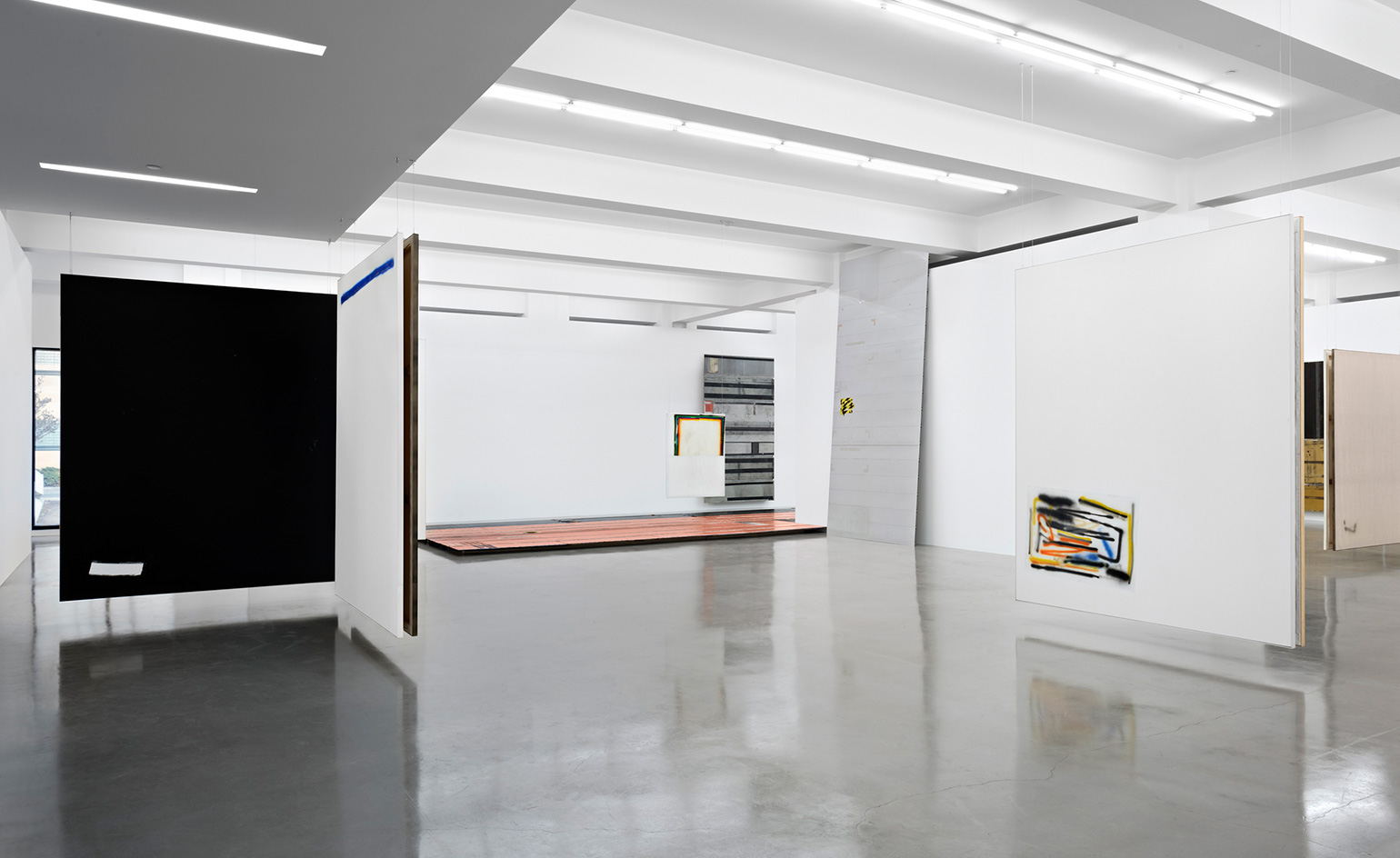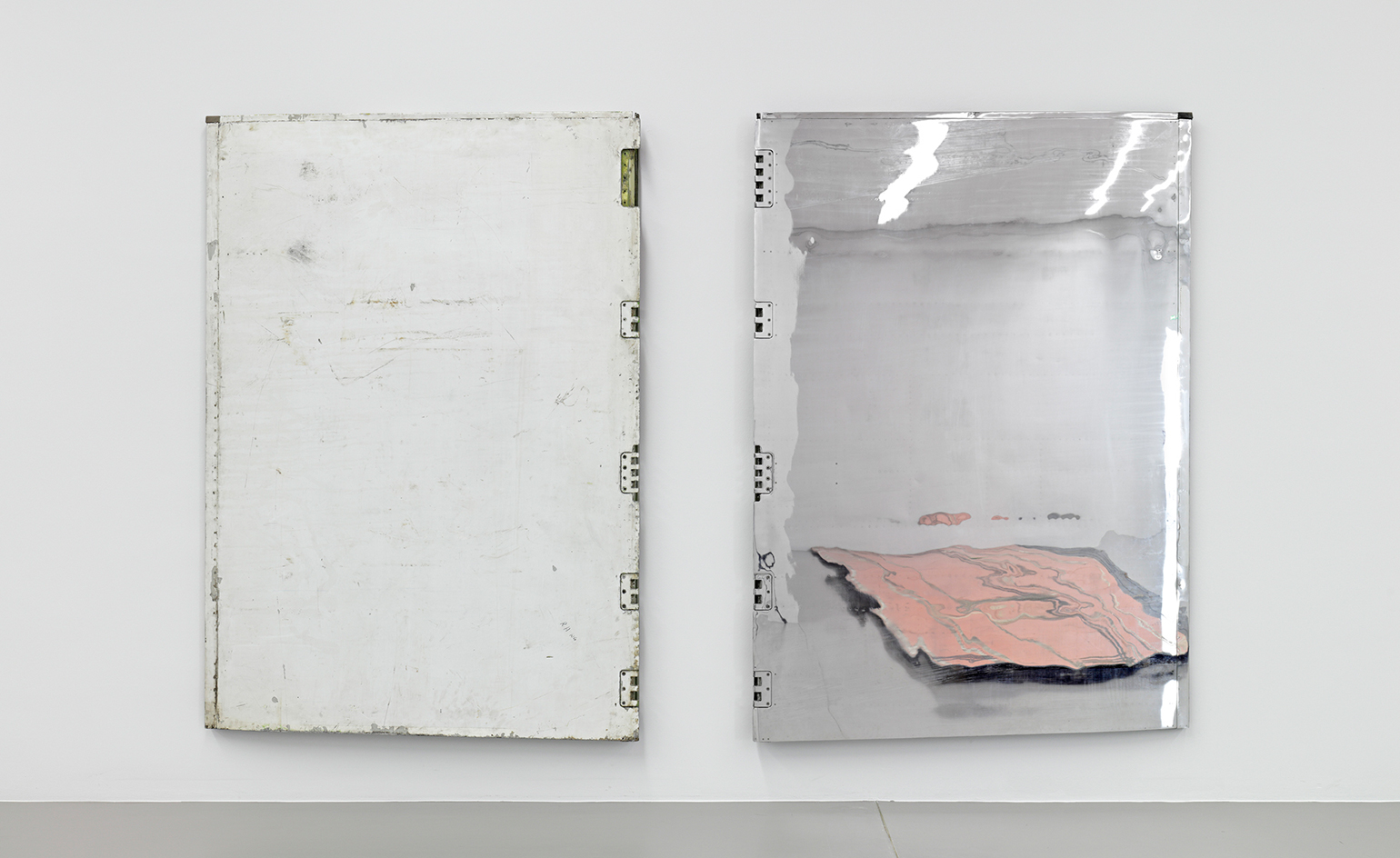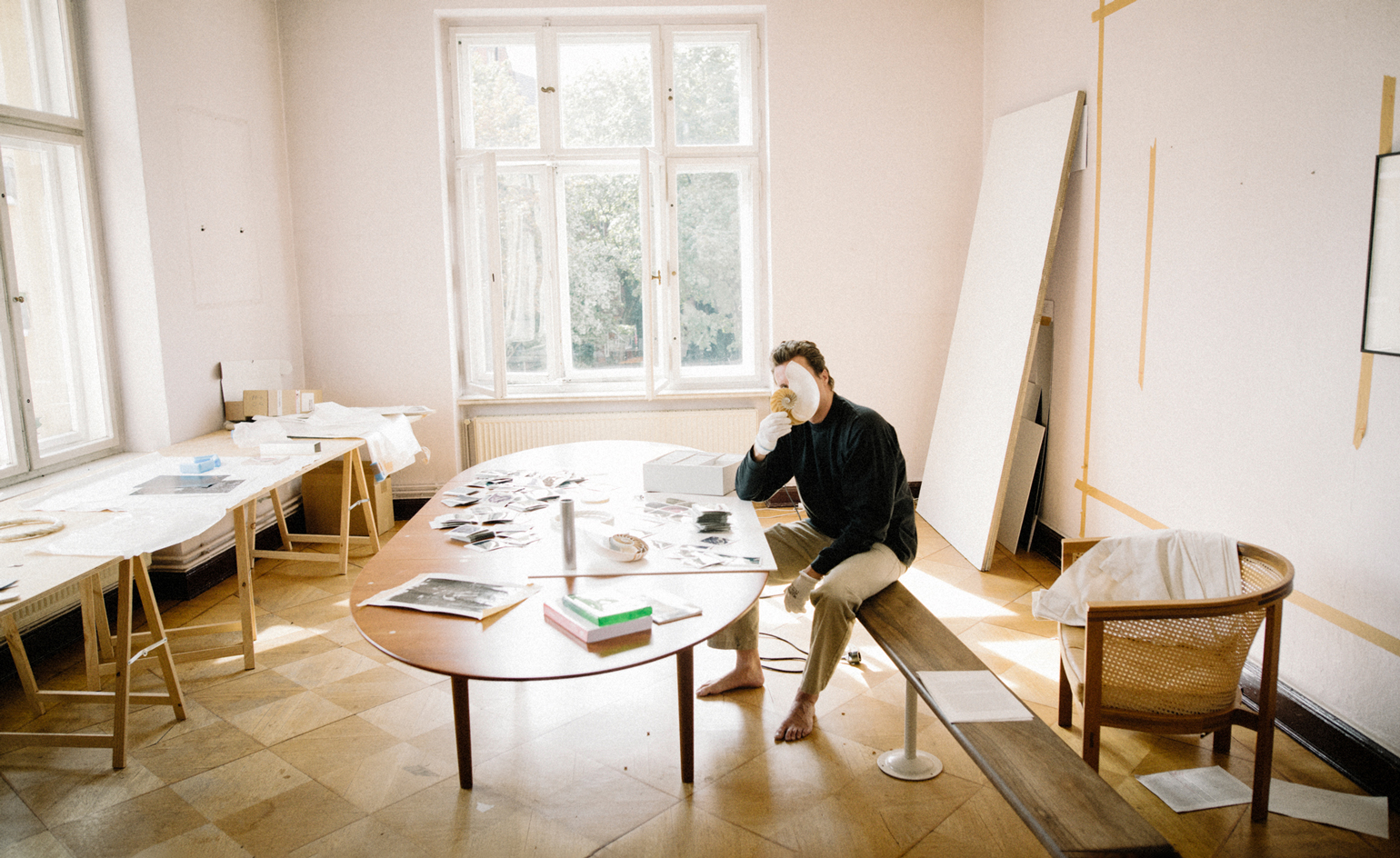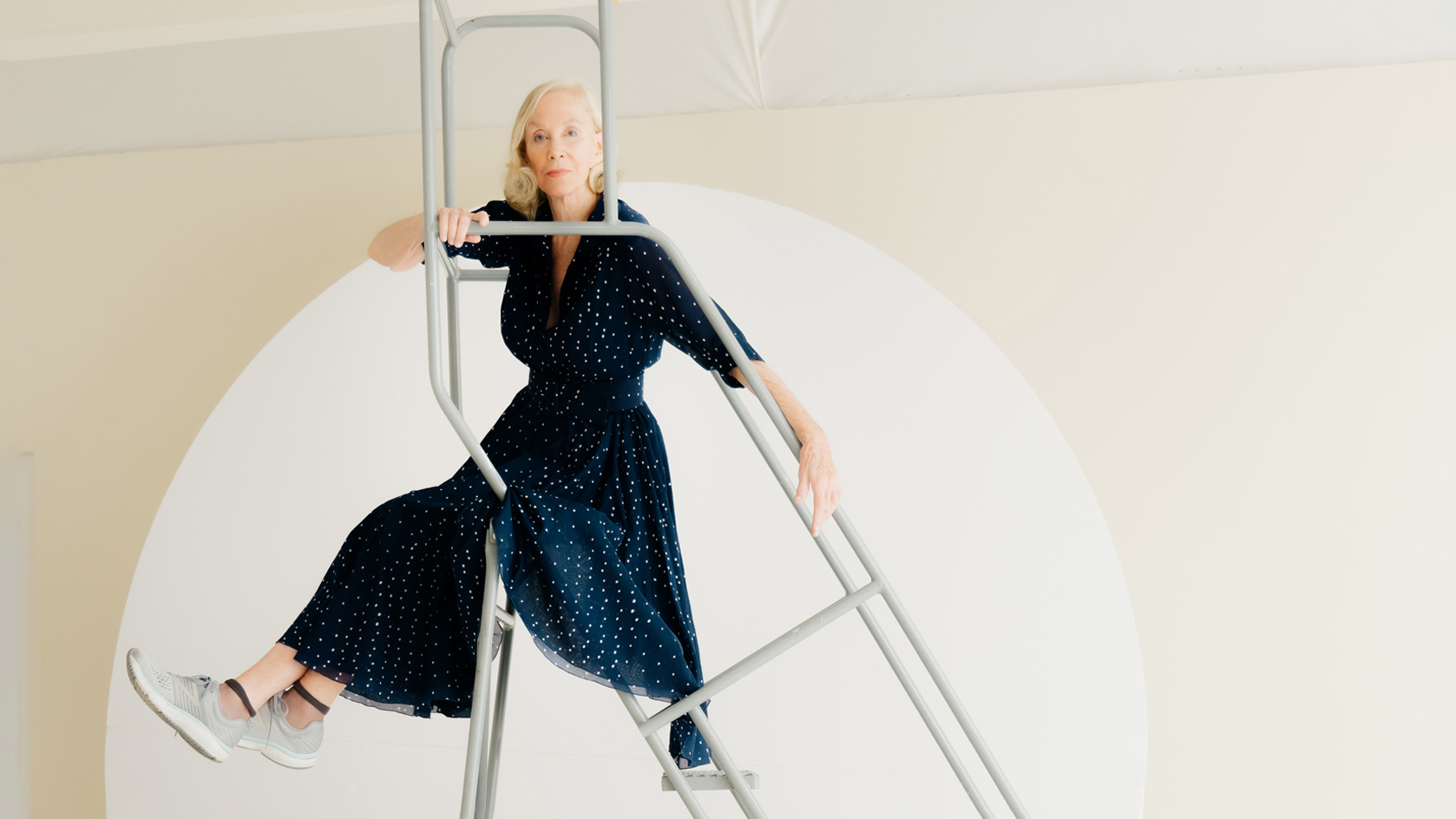Michail Pirgelis and David Ostrowski's visual affinities come into focus

Despite being good friends since college, and sharing a studio for a time, Cologne-based artists David Ostrowski and Michail Pirgelis rarely exhibit together. 'We each take on extremely different contextual issues in our work,' Ostrowski explains, 'and our working methods couldn’t be more different.' A joint exhibition in Sprüth Magers' Los Angeles outpost proves that despite these perceived differences, a coherent conversation between the two can be heard loud and clear. (No friendships were harmed during the process.)
It's only when the works are seen side by side that their visual affinities come into focus. Ostrowski's deeply abstract canvasses analyse the nature of painting, aiming to reduce it down to its bare bones. Blocks of black, grey and white are punctuated by stray, seemingly nonchalant gestures of vibrant spray-paint. Meanwhile, Pirgelis' enigmatic sculptures – that begin life as scrap metal in Californian aircraft boneyards – look like carefree groupings of found materials, untouched by an artists' hand. On closer inspection, both sets of works are impeccably detailed, highly considered and deceptively complex.

One of the aircraft boneyards in the Mojave Desert, where Pirgelis sources his materials from.
The 'simplistic' collections belie the immense conceptual effort behind them: their material interrogation, and the desire to use as few traditional artistic techniques as possible. 'I stopped working with oil paint because it offered too many possibilities,' Ostrowski explains. 'Spray paint, on the other hand, forces me to make constraints; you have to work quickly, and it’s nearly impossible to correct mistakes.'
He adds: 'There’s only a Plan A, almost never the possibility of a Plan B. The first shot counts. Too much action is overrated.' It's all down to 'how you can exude the highest possible emotions and power with the lowest possible means.'

The two artists’ work seemlessly together in their joint showcase at the Los Angeles gallery.
This hints towards a philosophical notion that paints a broader picture than Ostrowski's physical works. He is aiming at a new form of minimalism that goes beyond much of what we've seen before. Instead of using the idea of 'simple', he's interested in 'nothingness' – a kind of 'ground zero'. Perhaps why he works with reductive, inexpensive materials and processes - they are 'less laden with information'.
A similar sense of information underload can be seen in Pirgelis' sculptures. His enormous plane skeletons are dehabitualised when removed from their industrial, scrap yard setting. In their new gallery home, they become carte blanche objects, unburdened by their previous purpose.
This being said, Pirgelis is arguably less strict than Ostrowski in his commitment to 'nothingness' – he is prepared to embellish the raw object to achieve a desired finish. This is largely down to the unworkable attributes of his chosen materials. 'Airplanes are not made to be disassembled,' he explains. 'It’s actually quite rare that I come across an element that makes sense without any intervention whatsoever – but that is, of course, a nice fantasy.' He might peel off paint to uncover rivet drawings, or remove a few letters of branding, but Pirgelis aims to keep his artistic meddling to a minimum in order to maintain the power and momentum held in the original object.

Pirgelis’ enormous scrap yard pieces take on new meaning in a gallery setting.
Their materials and methods might differ, but there's an atmosphere of warmth and authenticity that pervades both sets of work; a lack of sterility that minimalist exhibitions often stuggle to avoid. Each piece is lightened by chance encounters. Specks of dirt here and there, the light trace of a vanishing footprint on the edge of a canvas, ghosts of masking-tape across a paintings' corner. Ostrowski encourages these mistakes; biographical traces that take a work from beautiful to brimming. These smudged fingerprints bare resemblance to the weathered, dust-blown textures of Pirgelis' plane-shells. Pock marked surfaces, wind-punched edges. The errors that other artists would spend hours polishing off or covering up, these artists celebrate.
But to break the rules you first must learn them. These artists have clearly studied a history of artistic movements, if only to not fall into them. Their work is almost impossible to categorise. It can't comfortably be described as minimalist, abstract, or even readymade. Ostrowski and Pirgelis are renegades, challenging themselves, and their audiences, to welcome a new, indefinable artistic moment.
Confounded by the gallery's position in oversaturated West Hollywood, 'Nothing Happened' is refreshing, but undeniably challenging. (It wouldn't be a Sprüth Magers exhibition if it wasn't.) Instead of 'nothingness' embodying what we think it means – an empty vacuum or a negation of 'something' – Ostrowski and Pirgelis are redefining it. They make it an active word; an occurrence, a weighty pause to dwell on. They seem to be saying, 'Nothing happened. And this is what it looks like.'

F (Chuzpe), and F (Fifty Shades of Tape), both by David Ostrowski, 2016

F (Sliver), by David Ostrowski, 2016; and Honey Depression, by Michail Pirgelis, 2016

Ostrowski in the two artists' temporary studio, Los Angeles, 2016

Since 2003, Pirgelis has made frequent visits to the aeroplane boneyards of Arizona and California.

Pirgelis’ sculptures are often carefully hybridised amalgams of these aircraft remains.

One trick pony (left), 2013, and Tresor, both by Michail Pirgelis.

Honey Depression, by Michail Pirgelis, 2016.

F (In Treatment), and F (A thing is a thing in a whole which it's not), both by David Ostrowski, 2016.
INFORMATION
’Nothing Happened’ is on view until 23 December. For more information, visit the Sprüth Magers website
ADDRESS
Receive our daily digest of inspiration, escapism and design stories from around the world direct to your inbox.
Sprüth Magers
5900 Wilshire Blvd
Los Angeles
Elly Parsons is the Digital Editor of Wallpaper*, where she oversees Wallpaper.com and its social platforms. She has been with the brand since 2015 in various roles, spending time as digital writer – specialising in art, technology and contemporary culture – and as deputy digital editor. She was shortlisted for a PPA Award in 2017, has written extensively for many publications, and has contributed to three books. She is a guest lecturer in digital journalism at Goldsmiths University, London, where she also holds a masters degree in creative writing. Now, her main areas of expertise include content strategy, audience engagement, and social media.
-
 Modernism for sale: a Norman Jaffe-designed icon on Shelter Island hits the market
Modernism for sale: a Norman Jaffe-designed icon on Shelter Island hits the marketThe Osofsky House epitomised the glamour of high-end 70s modernism on Long Island. Now updated and refurbished, it’s back on the market for the first time in over two decades
-
 Discover Locus and its ‘eco-localism' - an alternative way of thinking about architecture
Discover Locus and its ‘eco-localism' - an alternative way of thinking about architectureLocus, an architecture firm in Mexico City, has a portfolio of projects which share an attitude rather than an obvious visual language
-
 MoMA celebrates African portraiture in a far-reaching exhibition
MoMA celebrates African portraiture in a far-reaching exhibitionIn 'Ideas of Africa: Portraiture and Political Imagination' at MoMA, New York, studies African creativity in photography in front of and behind the camera
-
 What's the story with Henni Alftan’s enigmatic, mysterious paintings? The artist isn’t saying
What's the story with Henni Alftan’s enigmatic, mysterious paintings? The artist isn’t sayingParis-based artist Henni Alftan's familiar yet uncanny works are gloriously restrained. On the eve of a Sprüth Magers exhibition in Berlin, she tells us why
-
 Don’t miss: Thea Djordjadze’s site-specific sculptures in London
Don’t miss: Thea Djordjadze’s site-specific sculptures in LondonThea Djordjadze’s ‘framing yours making mine’ at Sprüth Magers, London, is an exercise in restraint
-
 Cyprien Gaillard on chaos, reorder and excavating a Paris in flux
Cyprien Gaillard on chaos, reorder and excavating a Paris in fluxWe interviewed French artist Cyprien Gaillard ahead of his major two-part show, ‘Humpty \ Dumpty’ at Palais de Tokyo and Lafayette Anticipations (until 8 January 2023). Through abandoned clocks, love locks and asbestos, he dissects the human obsession with structural restoration
-
 Year in review: top 10 art interviews of 2022, chosen by Wallpaper* arts editor Harriet Lloyd-Smith
Year in review: top 10 art interviews of 2022, chosen by Wallpaper* arts editor Harriet Lloyd-SmithTop 10 art interviews of 2022, as selected by Wallpaper* arts editor Harriet Lloyd-Smith, summing up another dramatic year in the art world
-
 Yayoi Kusama on love, hope and the power of art
Yayoi Kusama on love, hope and the power of artThere’s still time to see Yayoi Kusama’s major retrospective at M+, Hong Kong (until 14 May). In our interview, the legendary Japanese artist vows to continue to ‘create art to leave the message of “love forever”’
-
 Antony Gormley interview: ‘We’re at more than a tipping point. We’re in a moment of utter crisis’
Antony Gormley interview: ‘We’re at more than a tipping point. We’re in a moment of utter crisis’We visit the London studio of British sculptor Antony Gormley ahead of his major new show ‘Body Field’ at Xavier Hufkens Brussels
-
 Photographer Maisie Cousins on nostalgia, impulsive making and ‘collecting useless things’
Photographer Maisie Cousins on nostalgia, impulsive making and ‘collecting useless things’Explore the vision of British artist Maisie Cousins in ‘Through the lens’, our monthly series spotlighting photographers who are Wallpaper* contributors
-
 Anne Imhof ‘Avatar II’ review: a psychological thriller to make you wince and wonder
Anne Imhof ‘Avatar II’ review: a psychological thriller to make you wince and wonderGerman artist Anne Imhof’s ‘Avatar II’ exhibition at London’s Sprüth Magers is a compelling, uncanny probing of contemporary culture, reality and artifice